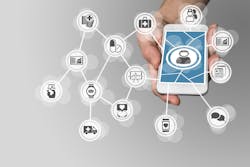Patient-generated health data from sensors and digital health apps holds the potential to fill gaps in care management in value-based care efforts. Although they are optimistic, however, health system clinical leaders are taking a measured approach to adoption.
In a June 18 HIMSS webinar, Michael Oppenheim, M.D., vice president and chief medical information officer of New York-based Northwell Health, described how the integrated health system is dipping its toes in patient-generated health data (PGHD) waters.
First, he outlined why PGHD is seen as important. Northwell provides a wide variety of services, including outpatient diagnostic, and skilled nursing. On the patient’s journey, they are touching care providers in all kinds of environments, some of which are outside Northwell. “That means we have a lot of gaps in data about the patient,” Oppenheim said. Northwell’s strategy, he added, is to look at its care from a longitudinal perspective through a centralized care management organization. “The flow of data is critical to make that approach efficient and effective. We started to look at patient-generated health data to supplement our ability to understand what is going on in places where we don’t get as much discrete data.”
Patient monitoring using things like Apple Watches or Fitbits or medical-grade monitors might seem like a slam dunk to implement, Oppenheim said. “The reality is there are quite a few challenges on taking sensor data in. The most important is dealing with the anticipated noise-to-signal ratio.”
In an intensive care unit, clinicians are used to anomalies when a sensor comes loose or a patient rolls over and they get an unusual vital sign. “The real challenge to continuous monitoring is that now in addition to noise with technical issues with sensors, you get young and healthy people doing vigorous exercise.” The physiologic data has to be read in the context of things that help you understand the activity. There needs to be artificial intelligence behind processing the signals to make them useful to clinicians so they are not chasing anomalous readings.
In addition, Oppenheim said, clinicians are going to start seeing devices with new parameters and not know their clinical significance. For instance, patient sensors are starting to offer a more holistic view of cardiovascular physiology. A device could offer continuous monitoring of cardiac output and systemic vascular resistance. “These sound exciting for use with heart disease patients,” he said. “Imagine the opportunities to know how well the heart is pumping. But we don’t know the normal variants.” The ability to measure is a research opportunity to try to understand signals, but initially clinicians won’t know what to do with them, he said.
Northwell is looking at working with a vendor of a monitor it would use for transitional care management during the high-risk period after a patient leaves the hospital, Oppenheim explained. The device measures normal heart and respiratory rate change for exercise and activity. Once the machine has learned the patient’s natural response to exercise, it goes into monitoring mode. If it sees a deviation — a heart rate or respiratory rate higher than it should be — it alerts the clinician. In a small study, he said, it saw deviations from the norm three or four days before the patient was sick enough to bring to the clinician’s attention.
Oppenheim’s colleague, Simita Mishra, Ph.D., a director in the Office of the CIO, said the health system has to ask several questions about patient-generated data, including whether adding the data is destructive to provider work flow. “Without buy-in from physicians, an initiative is not going to get any traction. We have to make sure it is blended seamlessly into their work flow.” Other questions: Is organizational data governance ready to accept and structure data in a meaningful way? Are we able to keep it secure? “These are all very legitimate concerns that cannot be overlooked as we get excited about patient-generated health data.”
“The message we want to convey is that we are interested in patient-generated health data,” Oppenheim said. “We think it will have tremendous value, but we have moved in a measured and careful way. We are trying to be conscious of provider and patient satisfaction.”
Actionability is key, he stressed. Northwell wants to work in small increments so that everyone starts to see value from their contribution and it doesn't become a thing patients or clinicians are asked to do for no good reason and the project gets abandoned.


